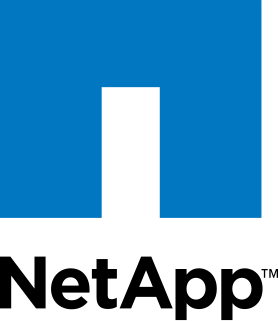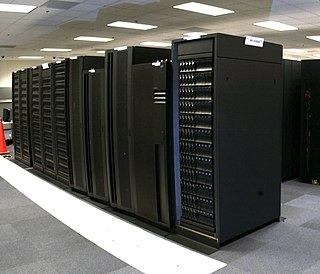Related Research Articles
Internet Small Computer Systems Interface or iSCSI is an Internet Protocol-based storage networking standard for linking data storage facilities. iSCSI provides block-level access to storage devices by carrying SCSI commands over a TCP/IP network. iSCSI facilitates data transfers over intranets and to manage storage over long distances. It can be used to transmit data over local area networks (LANs), wide area networks (WANs), or the Internet and can enable location-independent data storage and retrieval.
Quantum Corporation is a data storage and management company headquartered in San Jose, California. The company works with a network of distributors, VARs, DMRs, OEMs and other suppliers. From its founding in 1980 until 2001, it was also a major disk storage manufacturer, and was based in Milpitas, California. Quantum sold its hard disk drive business to Maxtor in 2001 and now focuses on integrated storage systems.
In information technology, a backup, or data backup is a copy of computer data taken and stored elsewhere so that it may be used to restore the original after a data loss event. The verb form, referring to the process of doing so, is "back up", whereas the noun and adjective form is "backup". Backups can be used to recover data after its loss from data deletion or corruption, or to recover data from an earlier time. Backups provide a simple form of disaster recovery; however not all backup systems are able to reconstitute a computer system or other complex configuration such as a computer cluster, active directory server, or database server.

NetApp, Inc. is an American hybrid cloud data services and data management company headquartered in San Jose, California. It has ranked in the Fortune 500 since 2012. Founded in 1992 with an IPO in 1995, NetApp offers cloud data services for management of applications and data both online and physically.
FICON is the IBM proprietary name for the ANSI FC-SB-3 Single-Byte Command Code Sets-3 Mapping Protocol for Fibre Channel (FC) protocol. It is a FC layer 4 protocol used to map both IBM's antecedent channel-to-control-unit cabling infrastructure and protocol onto standard FC services and infrastructure. The topology is fabric utilizing FC switches or directors. Valid rates include 1, 2, 4, 8 and 16 Gigabit per second data rates at distances up to 100 km.

Storage Technology Corporation was a data storage technology company headquartered in Louisville, Colorado. New products include data retention systems, which it calls "information lifecycle management" (ILM).

The HPE Storage is a portfolio of HPE storage products, includes online storage, nearline storage, storage networking, archiving, de-duplication, and storage software. HP and their predecessor, the Compaq Corporation, has developed some of industry-first storage technologies to simplify network storage. HP is a proponent of converged storage, a storage architecture that combines storage and compute into a single entity.
Veritas Backup Exec is a data protection software product designed for customers with mixed physical and virtual environments, and who are moving to public cloud services. Supported platforms include VMware and Hyper-V virtualization, Windows and Linux operating systems, Amazon S3, Microsoft Azure and Google cloud storage, among others. All management and configuration operations are performed with a single user interface. Backup Exec also provides integrated deduplication, replication, and disaster recovery capabilities and helps to manage multiple backup servers or multi-drive tape loaders.

Overland Storage is a wholly owned subsidiary of Sphere 3D Corp. It has acquired Tandberg Data shortly before being acquired by Sphere 3D itself. The two subsidiaries were later rebranded under the common Overland-Tandberg brand.

The IBM Storage product portfolio includes disk, flash, tape, NAS storage products, storage software and services. IBM's approach is to focus on data management.
Catalogic DPX is an enterprise-level data protection tool that backs up and restores data and applications for a variety of operating systems. It has data protection, disaster recovery and business continuity planning capabilities. Catalogic DPX protects physical or virtual servers including VMWare and vSphere, supports many database applications, including Oracle, SQL, SharePoint, and Exchange. DPX supports agent-based or agent less backups. Users can map to and use a backed up version of the database if something goes wrong with the primary version. DPX is managed from a single console and catalog. This allows for centralized control of both tape-based and disk-based data protection jobs across heterogeneous operating systems. DPX can protect data centers, remote sites and supports recovery from DR. DPX can protect data to disk, tape or cloud. It is used for various recovery use cases including file, application, BMR, VM or DR. DPX can spin up VMs from backup images, recover physical servers, bring up applications online from snapshot based backups, it can be used to recover from Ransomware.

A storage area network (SAN) or storage network is a computer network which provides access to consolidated, block-level data storage. SANs are primarily used to access data storage devices, such as disk arrays and tape libraries from servers so that the devices appear to the operating system as direct-attached storage. A SAN typically is a dedicated network of storage devices not accessible through the local area network (LAN).

Luminex Software, Inc. is a developer and provider of mainframe connectivity, storage and data protection solutions, including virtual tape and data integration products.

StorSimple was a privately held company based in Santa Clara, California, marketing cloud storage.
Cofio Software, headquartered in San Diego, California, was a privately held software company founded in 2006 which produced a product called AIMstor. After being acquired in 2012 the product became known as the Hitachi Data Instance Director.
NetVault is a set of data protection software developed and supported by Quest Software. NetVault Backup is a backup and recovery software product. It can be used to protect data and software applications in physical and virtual environments from one central management interface. It supports many servers, application platforms, and protocols such as UNIX, Linux, Microsoft Windows, VMware, Microsoft Hyper-V, Oracle, Sybase, Microsoft SQL Server, NDMP, Oracle ACSLS, IBM DAS/ACI, Microsoft Exchange Server, DB2, and Teradata.
Software-defined storage (SDS) is a marketing term for computer data storage software for policy-based provisioning and management of data storage independent of the underlying hardware. Software-defined storage typically includes a form of storage virtualization to separate the storage hardware from the software that manages it. The software enabling a software-defined storage environment may also provide policy management for features such as data deduplication, replication, thin provisioning, snapshots and backup.
Veeam Software is a privately held US-based information technology company owned by Insight Partners that develops backup, disaster recovery and modern data protection software for virtual, physical and multi-cloud infrastructures. The company's headquarters are in Baar, Switzerland and Columbus, Ohio, United States.

Veeam Backup & Replication is a proprietary backup app developed by Veeam for virtual environments built on VMware vSphere, Nutanix AHV, and Microsoft Hyper-V hypervisors. The software provides backup, restore and replication functionality for virtual machines, physical servers and workstations as well as cloud-based workload.
Dell EMC VMAX is Dell EMC’s flagship enterprise storage array product line. It evolved out of the EMC Symmetrix array, EMC’s primary storage product of 1990s and early 2000s.
References
- ↑ "History of VTL/IBM".
- ↑ "InfoStor ESG Report on FalconStor Virtual Tape Library".
- ↑ "The Rise, Fall, and Rise, of Virtual Tape Libraries".
- ↑ "Integration of AWS Storage Gateway with Veeam – Backups and backup copy in Cloud". orgedelacruz.uk. Retrieved 6 September 2017.
- ↑ "Setting Up a Veeam to StarWind Virtual Tape Library Configuration". mpecsinc.com. Retrieved 3 March 2020.
- ↑ "Archive backups with Veeam and StarWind Virtual Tape Library". tech-coffee.net. Retrieved 20 April 2018.
- ↑ "Complete the Backup Lifecycle with Veeam's SOBR Archive Tier". Veeam. Retrieved 4 March 2021.